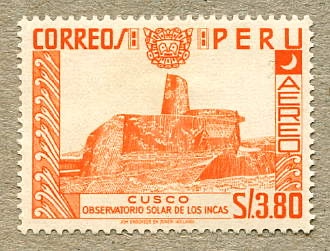Peru 1952 – Inca observatory
Although the inscription on the stamp identifies Cusco as the location of this Inca monument, it is in fact the Intihuatana stone at the ancient ‘lost city’ of Machu Picchu, over 40 miles to the northwest. The Intihuatana stone is a pillar surrounded by an irregular pedestal carved out of the rock on a mountain peak, and stands some 6 ft high overall. The corners of the central pillar are aligned to the four main compass points, while the pedestal is aligned on the setting point of the Sun at the December solstice (summer in the southern hemisphere).
Dr Ed Krupp of the Griffith Observatory in Los Angeles, an expert in archaeoastronomy, describes it as follows in his book Echoes of the Ancient Skies: ‘The intihuatana at Machu Picchu is a mass of granite about the size and height of a large dining room table. Carved from the rocky summit of an 80-foot-high natural pyramid, this peculiar combination of oddly angled surfaces, corners and projections has defied interpretation.’
The name ‘Intihuatana’ is usually translated as ‘hitching post of the Sun’. Inca priests are said to have symbolically lassoed the Sun to the pillar either at the June solstice or the equinoxes (opinions differ). In the case of the June solstice, the Sun would have been at its most northerly (and lowest in the sky) as seen from this southern hemisphere location. It is said that the stone is angled at 13°, equal to the latitude of the site, so that at noon at the equinoxes it casts no shadow. As with all such ancient monuments, its true purpose may never be known and many descriptions of it are coloured by mysticism.
Other structures lower down the same hillside at Machu Picchu are also thought to have had an astronomical significance.
The original 1952 issue of this stamp, which qualifies for inclusion in this listing, had a face value of 2.20 s and was printed in blue; shown above is the same design reissued in 1959 (i.e. beyond our 1957 cutoff) with a value of 3.80 s and in orange (SG 836).
SG number
Face value
Colour
788
2.20 s
Blue
